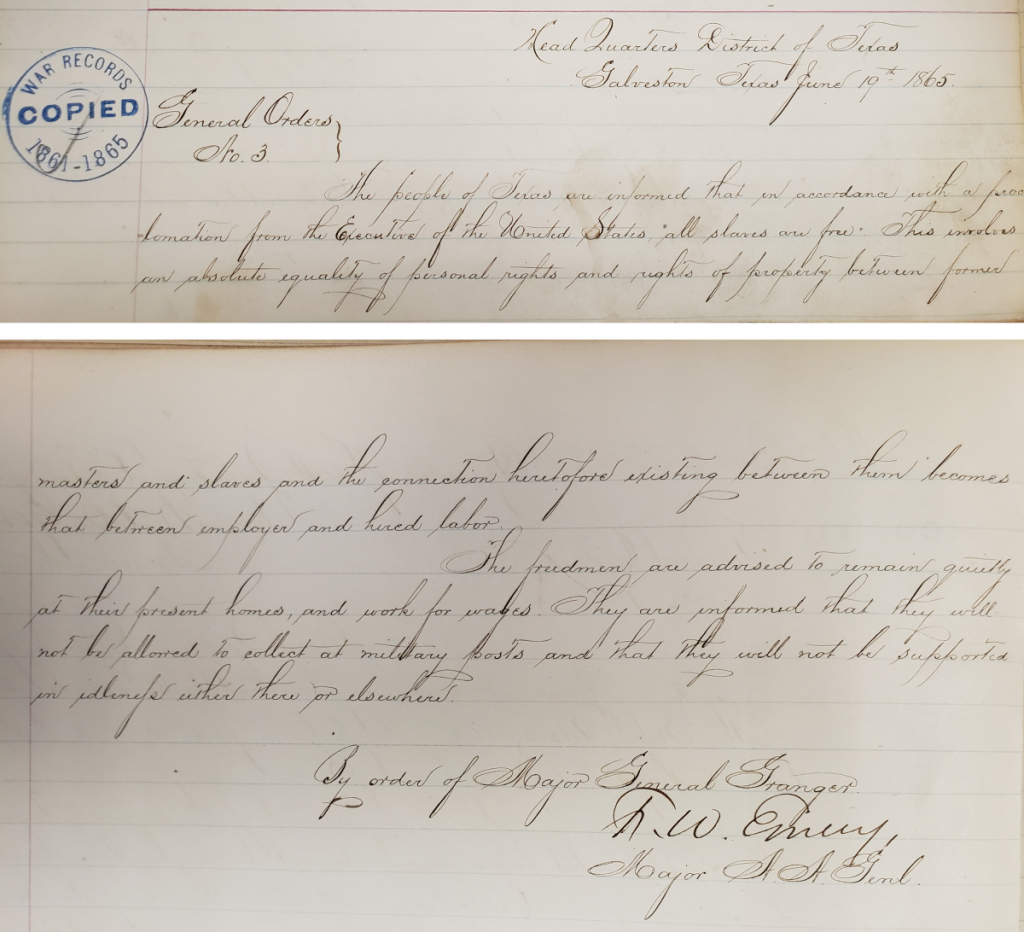On June 19, 1865, in Galveston, Texas, Major General Gordon Granger of the Union Army issued General Order No. 3, a handwritten directive enforcing the Emancipation Proclamation of 1863 for all remaining enslaved persons in the state.

The legal abolition of American slavery would come six months later in December of 1865, when Congress ratified the 13th Amendment to the Constitution: “Neither slavery nor involuntary servitude, except as a punishment for crime whereof the party shall have been duly convicted, shall exist within the United States, or any place subject to their jurisdiction.” Though December 1865 marks the legal dismantling of American slavery, the celebration of June 19 as “Black Independence Day” acknowledges both Emancipation itself as well as the lived distinction between law on the books and facts on the ground.
Though enslaved people — in Texas and throughout the United States — had long known about Lincoln’s Proclamation, its message remained only an intention until its enforcement could be enacted by the Union Army in the defeated, though still slave-holding, South. In the decades following the end of the Civil War, and the ratification of the 13th, 14th, and 15th Amendments, the enforcement of these new laws — which aimed to dramatically re-shape a nation structured by racial inequality — depended on the presence of a U.S. Army force throughout the recalcitrant White South. During this period of enforcement, which later became known as Reconstruction, formerly enslaved African Americans achieved significant gains in economic empowerment and political representation. But in 1877, an unwritten deal struck between those in power on both sides of the former Mason-Dixon Line compelled the U.S. Army to withdraw from the South, thus ending its enforcement of the new laws. This withdrawal commonly marks the beginning of what would become known as the Jim Crow era, a nearly 100-year period of racial apartheid in which, by both law and custom, African Americans were systematically excluded from equal participation in the political, social, and economic life of the nation.
Throughout this 100-year period, activists, artists, writers, lawyers, and ordinary citizens would risk their lives to enforce the spirit of the 14th Amendment, ratified in 1868: “No state shall make or enforce any law which shall abridge the privileges or immunities of citizens of the United States; nor shall any state deprive any person of life, liberty, or property, without due process of law; nor deny to any person within its jurisdiction the equal protection of the laws.” After decades of activism and legal challenges, by 1968 the legality of racial apartheid was — once again — defeated.
In the years following the enactment of the Civil Rights Act, draconian laws were passed that ushered in a new era of systematized injustice and racial oppression. This reality continues to demand the kind of pressure and action that has characterized the fight for equality since the nation’s declaration of its own independence. As civil rights lawyers, we seek to secure justice for our clients to the fullest extent of the law. But many injustices cannot be redressed in Court, and even more injustices are actually permitted by the law. Real change—change that disrupts systems of oppression and removes power from systems of oppression—requires action from lawmakers and politicians. Mass incarceration is a direct result of our criminal legal system. Extreme poverty, police brutality, and youth incarceration are policy choices.
The delay in the enforcement of law is a story repeated many times, in many ways, into the twentieth- and now twenty-first centuries, when the spirit of its intent as an equalizing and humanizing force becomes real only when people take deliberate action in order to make it so.
Today we celebrate Juneteenth, and all it represents: the national ideals of freedom, equality, and the deliberate action and commitment their enforcement demands.
